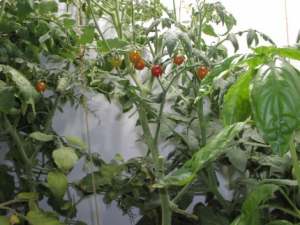The Urban Farmer, Issue #113
June, 2009:
Beat the Bugs! * Truncheons *Dear Simon: Use Bleach?

Sweet cherry tomatoes in my grow closet
”
Great God of little things
Look down upon my labors
And make my little garden
A little better than my neighbors!”
~Lynwood L. Giacomini
Pests & Plagues: Beat Those Bugs!

With summer approaching, you may well start to
find some bugs in your hydroponic garden. How the heck do aphids find their way
into your closed off bedroom? This is one of the mysteries of indoor gardening,
and I don’t have a scientific answer for it. I just know that sometimes, bug
just appear spontaneously!
You may even have heard that there are no pests
in hydroponic gardens. NOT! Hydroponics does give you an advantage for dealing
with them, though. In your small home-based garden, you can contain the
crops easily for treatment And the biggie: it’s easier to take preventive
measures.
Cleanliness: Your most powerful tool for beating pest and diseases is
cleanliness. Dead decaying vegetation provides the perfect breeding ground for
pests and disease to take hold. Keep your growing area clean! The hallmark of a
true hydroponics expert is a clean garden. So take the time each day to pluck or
prune off dead leaves and stems, and to remove them where they have fallen. A
clean garden is a happy garden!
System controls: If your hydro system is monitored regularly and operated
properly, you will have fewer pests and diseases to deal with. It’s been proven
that stressed plants put out “vibes” to insects that there are sick plants which
need to be cleaned up! This is nature’s way, and works great in the forest, but
is not so welcome in your hydro unit. If you keep plenty of ph-balanced,
nutrient rich solution and feed your plants regularly, and control the climate,
they will remain healthy and better able to battle bug infestations themselves.
Mechanical damage: Every time you break, crack or bruise a plant, you
have set it up for a potential disease infestation. It weakens the plant and
allows an opportunity for diseases and pests to take a foothold. So treat your
babies gently, support vines properly so they don’t split, and prune cleanly
with garden shears. Your plants will thank you.
Air and Oxygen: Good airflow in a grow area prevents moisture from
building up on the leaves. Moisture is an ideal atmosphere for viruses and
fungus in particular. Good air movement also cuts down on plant stress by
helping them breathe (transpire) more easily. Outside, Mother Nature takes care
of this basic need. In your den, you have to lend a hand with a gentle
oscillating fan. Every leaf on every plant should be moving slightly, 24/7.
Bringing Home Bugs: If you want a true challenge in pest management,
bring home some seedling plants from the local garden center. If you don’t
quarantine and pre-treat them, I guarantee you will have a swarm of insects on
the rest of your beautiful hydro plants in a few short days! A true large-scale
invasion is heartbreaking and almost impossible to treat. You might as well rip
everything out, sterilize, and start over. (Listen to the voice of experience
here). If you just must use store-bought seedlings, de-lice them first. Follow
the procedure outlined at the bottom of this page:
Seeds &
Seedlings .
It is much easier to keep a careful eye on your garden and head trouble off at
the pass. Pay attention. Inspect your plants daily. Remove dead debris, pluck
off any creatures you find, and make sure your system is running properly. When
it comes to pests and diseases, it is much easier to prevent than to cure!
So What Is A Truncheon?

What is a truncheon? It is a “wand” type meter which reads how strong your
nutrient solution is. That’s all. Truncheon is just a common name for the
“stick” that is dipped into the reservoir. The sensor in the end of the wand
measures the amount of dissolved solids (fertilizer salts), and gives a readout
of the results.
An EC meter, or truncheon, is not a necessity. It is relatively expensive, and I
advise you to wait until you are heavily into hydroponics, have some experience
under your belt, and want to fine tune and tweak your system. A truncheon will
give you instant specialized feedback any time you need it.
Keep in mind that the device can only measure the total amount of solids in your
vat juice; it cannot tell you levels of the individual minerals that make up the
solution.
There is no need to understand the underlying science behind all of this. The
use of your truncheon is a simple matter. It will give you a readout in either
PPM (parts per million) or EC (electrical conductivity), take your pick. Here in
the states, we tend to use PPM.
When you first mix up a batch of solution, take a reading. Then future readings
can be compared to your starting number. As your reservoir level drops, you will
replenish with water only, not more nutrient solution. Why? only the water
evaporates, not the solids. So just adding water should keep it in a good range.
When the PPM level drops too low, it is time to either add some fresh solution,
or empty the vat and mix a whole new batch.
So what are the magic numbers? Keep the PPM between:1120 and 1680 (EC of 1.6 to 2.4)
A few other tips on use:
When taking a reading, dip the truncheon into the reservoir and let it adjust to
the temperature for a couple minutes first.
After use, flush the probe off with clean water and wipe it with a paper towel
to avoid salt buildup.
Don’t forget to turn it off after use to save the batteries, and replace them
regularly to avoid false readings.
I have a bluelab brand truncheon and have been very happy with it.
Now that wasn’t hard, right? Keep it simple!
Dear Simon: Use Bleach?

Dear Simon:
Hello There.
Have You Ever Ran Into Problems Using Coco Coir?
I Usually Just Soak And Rinse Mine In Warm Water, But I Read You Use 10% Diluted
Bleach… How Does That Work Out?
Do You Have Any Tips To Follow To Get The Best Out Of Coco Coir?
~Tyler from Canada
Hi Tyler,
Coco coir is a nice absorbent hydroponic medium. I like to mix it 50-50 with
perlite, for a good light but absorbent mix.
You don’t have to rinse it for first use, just add water to the brick per label
instructions to hydrate it.
I only use the bleach solution to try to sterilize it after it has been
used in a garden,
to kill any possible bugs or diseases that may have taken hold during the
growing season.
You must rinse it thoroughly afterwards to remove all the bleach.
Sterilizing it allows you to reuse the coco a few times and so save money.
Good luck!
Stella
We hope you have enjoyed this issue of The Urban Farmer Ezine. Each month, we will bring you another inspiring photo, gardening quote or idea, plus fresh new hydroponics news, techniques & products.
Insiders tips to get you growing…

~Stella and Simon from Hydroponics-Simplified.com
|


Reply